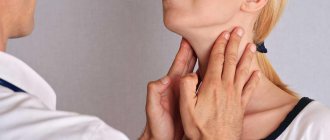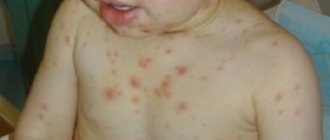Pemphigus symptoms
The characteristic symptoms of pemphigus are a rash of small blisters with serous contents. Their localization depends on what form of the disease develops:
- ordinary - rashes appear on the mucous membrane, accompanied by an unpleasant odor;
- leafy – blisters form on the skin, and crusts form at the same time;
- non-acantholytic - rashes are located on the mucous membrane and lips. This form of pathology is more often diagnosed in old age.
With pemphigus in children and adults, the following are also observed:
- severe weakness;
- increased drowsiness;
- deterioration or complete loss of appetite;
- losing weight even while eating high-calorie foods.
To detect pemphigus in newborns, older children and adults, the following examination methods are used:
- examination of the patient and assessment of rashes;
- Nikolsky test - with its help, differential diagnosis with other skin diseases is carried out;
- histological and cytological examination.
The symptoms of pemphigus (the second name of the disease) are often similar to the symptoms of other pathologies that will require completely different therapy. Therefore, before prescribing treatment, a thorough study of the symptoms that have arisen will be required.
General notes on therapy
- For superficial forms of pyoderma, the use of topical antiseptics, aniline dyes, and external antibacterial drugs is recommended.
- Systemic antibacterial agents are prescribed for widespread, deep, chronic, recurrent pyoderma, in the absence of effect from external therapy, the presence of general phenomena (fever, malaise) and regional complications (lymphadenitis, lymphangitis), localization of deep pyoderma on the face.
- Glucocorticosteroids for systemic use are prescribed for high activity of the pathological process, for chronic ulcerative-vegetative and gangrenous pyoderma.
- Systemic retinoids are prescribed for keloid acne, abscess folliculitis and scalp perifolliculitis.
- Immunobiological agents are prescribed in cases of recurrent, persistent forms of pyoderma.
- The regimen of a patient with pyoderma involves rational skin care both in the lesion and outside it. In case of a disseminated process, frequent water procedures and hair removal by shaving are not recommended. It is recommended to cut the hair in the area where pyodermic elements are located.
- In case of long-term infectious and inflammatory processes, as well as in case of multiple rashes, certain attention should be paid to diet: nutrition should be complete, rich in vitamins, the amount of salt and carbohydrates is sharply limited, and alcohol is completely excluded.
indications for hospitalization
- diseases associated with the action of toxin-produced strains of staphylococcus and streptococcus;
- widespread rashes accompanied by a violation of the general condition.
requirements for treatment results
- resolution of pathological skin elements;
- epithelization, scarring of ulcers;
- reducing the frequency of disease relapses in chronic forms of pyoderma.
prevention
- Primary prevention of pyoderma consists of timely antiseptic treatment of microtraumas, cracks, and wound surfaces. It is necessary to treat identified common diseases against which pustular skin lesions may develop (diabetes mellitus, diseases of the digestive tract, respiratory system, etc.).
- Secondary prevention of pyoderma includes periodic medical examinations and, if necessary, anti-relapse therapy (general UV irradiation, skin care, sanitation of focal infection).
External therapy
1. Antiseptic preparations for external use:
- solution of brilliant green, alcohol 1% externally to the area of rash 2-3 times a day for 7-14 days, or
- fucorcin, alcohol solution applied externally to the area of rash 2-3 times a day for 7-14 days, or
- methylene blue, aqueous solution 1% externally to the area of rash 2-3 times a day for 7-14 days, or
- potassium permanganate, aqueous solution 0.01-0.1% externally to the area of rash 2-3 times a day for 7-14 days, or
- hydrogen peroxide solution 1-3% externally on the rash area 2-3 times a day for 7-14 days, or
- chlorhexidine, alcohol solution 0.5%, aqueous solution 0.05-1% externally to the area of rash 2-3 times a day for 7-14 days, or
- povidone-iodine, 10% solution applied externally to the area of the rash 2-3 times a day for 7-14 days.
2. Antibacterial drugs for external use:
- neomycin sulfate (5000 IU/5 mg) + bacitracin zinc (250 IU) externally to the area of rash 2-3 times a day for 7-14 days, or
- gentamicin sulfate, ointment or cream 0.1% (d) externally to the area of rash 3-4 times a day for 7-14 days, or
- fusidic acid, cream or ointment 2% externally to the area of rash 3-4 times a day for 7-14 days, or
- mupirocin, 2% ointment applied topically to the area of rash 2-3 times a day for 7-14 days, or
- erythromycin, ointment (10,000 units/g) externally to the area of rash 2-3 times a day for 7-14 days, or
- lincomycin hydrochloride, 2% ointment applied externally to the area of rash 2-3 times a day for 7-14 days, or
- silver sulfathiazole, 1% cream applied externally to the area of rash 1-2 times a day for 7-10 days for 7-14 days.
3. Glucocorticosteroid topical agents combined with antibacterial drugs:
Prescribed in the case of an acute inflammatory process accompanied by erythema, swelling, itching, and more often in the presence of itchy dermatoses complicated by secondary pyoderma:
- tetracycline hydrochloride + triamcinolone acetonide, aerosol applied externally to the area of rash 2-4 times a day for 5-10 days, or
- hydrocortisone acetate + oxytetracycline hydrochloride, ointment, aerosol applied externally to the area of the rash 1-3 times a day for 5-10 days, or
- fusidic acid + betamethasone, cream applied externally to the rash area 2-3 times a day for 7-14 days, or
- fusidic acid + hydrocortisone, cream applied externally to the rash area 3 times a day for 7-14 days, or
- betamethasone valerate + gentamicin sulfate, cream, ointment (B) externally to the area of rash 1-2 times a day for 7-14 days;
- betamethasone dipropionate + gentamicin sulfate, cream, ointment (B) externally to the area of the rash 2 times a day for 7-14 days.
Systemic therapy
1. Antibacterial drugs of the penicillin group:
- benzylpenicillin sodium salt: children - 25,000-50,000 units per kg of body weight per day intramuscularly, adults - 2,000,000-12,000,000 units per day intramuscularly. The drug is administered every 4-6 hours for 7-10 days, or
- amoxicillin trihydrate: children under 2 years of age - 20 mg per kg of body weight per day orally, children aged 2 to 5 years - 125 mg 3 times a day orally, children aged 5 to 10 years - 250 mg 3 times per day orally, for children over 10 years of age and adults - 500 mg 3 times a day orally. The course of treatment is 7-10 days, or
- amoxicillin: children under 3 years of age - 30 mg per kg of body weight per day in 2-3 doses orally, children aged 3 to 10 years - 375 mg 2 times a day orally, children over 10 years of age and adults -500 -750 mg 2 times a day orally. The course of treatment is 7-10 days, or
- amoxicillin trihydrate + clavulanic acid: children aged 3 months to 1 year - 2.5 ml of suspension 3 times a day orally, children aged 1 to 7 years - 5 ml of suspension 3 times a day orally, children aged from 7 to 14 years old - 10 ml of suspension or 5 ml of suspension forte 3 times a day orally, children over 14 years of age and adults - 1 tablet (250 + 125 mg) 3 times a day or 1 tablet (500 + 125 mg) ) 2 times a day orally. The course of treatment is 7-10 days.
2. Antibacterial drugs of the cephalosporin group:
- cephalexin: children weighing less than 40 kg - 25-50 mg per kg body weight per day orally, adults and children over 10 years of age - 250 - 500 mg orally 4 times a day. The course of treatment is 7-14 days, or
- cefazolin: children - 20-40 mg per kg of body weight per day intramuscularly or intravenously, adults - 1 g per day intramuscularly or intravenously. The frequency of administration is 2-4 times a day. The course of treatment is 7-10 days, or
- cefaclor: children under 6 years of age - 30 mg per kg of body weight per day orally in 3 divided doses, children aged 6 to 10 years - 250 mg orally 3 times a day, children over 10 years of age and adults - 500 mg orally 3 times a day. The course of treatment is 7-10 days, or
- cefuroxime: children - 125-250 mg orally 2 times a day, adults - 250-500 mg orally 2 times a day. For parenteral administration: children under 3 months of age - 30 mg per kg of body weight (daily dose) 2-3 times a day, children over 3 months of age - 60 mg per kg of body weight (daily dose) 3-4 times a day , adults - 750 mg-1.5 g 3 times a day. The course of treatment is 7-10 days, or
- cefotaxime: children weighing less than 50 kg - 50-100 mg per kg body weight per day intravenously or intramuscularly with an administration interval of 6-8 hours, children weighing more than 50 kg and adults - 2.0-6.0 g per day day intravenously or intramuscularly with an administration interval of 8-12 hours. The course of treatment is 5-10 days, or
- Ceftriaxone: children under 12 years of age - 50-75 mg per kg of body weight 1 time per day intramuscularly, children over 12 years of age and adults - 1.0-2.0 g 1 time per day intramuscularly. The course of treatment is 7-10 days.
3. Antibacterial drugs of the macrolide group:
- erythromycin: children under 3 months of age - 20-40 mg per kg of body weight per day, children aged from 3 months to 18 years - 30-50 mg per kg of body weight per day, adults - 1.0-4.0 g orally per day in 4 doses. The course of treatment is 5-14 days, or
- azithromycin: children - 10 mg per kg body weight 1 time per day orally for 3 days, adults - 500 mg orally 1 time per day for 3 days, or
- Clarithromycin: children - 7.5 mg per kg body weight per day orally, adults - 500-1000 mg per day orally. The frequency of administration is 2 times a day. The course of treatment is 7-10 days.
4. Antibacterial drugs of the tetracycline group:
doxycycline: for children over 12 years of age and/or with body weight less than 50 kg - 4 mg per kg of body weight once a day on the 1st day, 2 mg per kg of body weight once a day on subsequent days; children over 12 years of age and/or weighing more than 50 kg and adults - 100 mg orally 2 times a day for 10-14 days.
5. Antibacterial drugs of the fluoroquinolone group:
- ciprofloxacin 250-500 mg 2 times a day orally for 5-15 days, or
- Levofloxacin: 250-500 mg orally 1-2 times a day for 7-14 days, or
- ofloxacin: 200-400 mg orally 2 times a day for 7-10 days.
6. Antibacterial drugs of the lincosamide group:
clindamycin: children - 3-6 mg per kg body weight orally 4 times a day, adults 150-450 mg orally 4 times a day; when administered parenterally to children, 15-40 mg per kg of body weight per day, to adults - 600 mg-2.7 g per day, frequency of administration 3-4 times per day. The course of treatment is 10 days.
7. Antibacterial sulfonamide drugs:
sulfamethoxazole + trimethoprim: children aged 3 to 5 years - 240 mg orally 2 times a day; children aged 6 to 12 years - 480 mg orally 2 times a day; adults and children over 12 years of age -960 mg orally 2 times a day. The course of treatment is from 5 to 14 days.
8. Glucocorticosteroid drugs for systemic use (for ulcerative, ulcerative-vegetative pyoderma):
- prednisolone 25-30 mg per day intramuscularly for 5-7 days with a gradual dose reduction until discontinuation, or
- dexamethasone phosphate 4 mg (1 ml) 4-6 mg per day intramuscularly for 5-7 days with a gradual dose reduction until discontinuation, or
- betamethasone disodium phosphate + betamethasone dipropionate 1-2 ml intramuscularly once, if necessary, repeat the administration after 10 days.
9. Systemic retinoids: isotretinoin 0.5-1.0 mg per kg body weight per day orally for 3-4 months.
10. Immunobiological agents:
- purified liquid staphylococcal toxoid in 1 ml 12 ± 2 EU of staphylococcal toxoid: in increasing doses: 0.1,0.3,0.5,0.7,0.9,1.2 and 1.5 ml subcutaneously with an interval of 2 days; per course of treatment - 7 injections. The drug is not used simultaneously with treatment with serum antistaphylococcal drugs (immunoglobulin plasma) or
- staphylococcal medicinal liquid vaccine (staphylococcal antifagin), 1 ml: children aged 6 months to 7 years - 0.1 ml subcutaneously daily; for children over 7 years of age, the initial dose is 0.2 ml subcutaneously, then increase the dose by 0.1 ml daily for 8 days. Repeated course of treatment after 10-15 days in case of extensive skin lesions with relapses, or
- human antistaphylococcal immunoglobulin liquid, 100 IU: for mild forms of pyoderma 100 IU per day intramuscularly, for generalized infection 5 IU per kg of body weight per day intramuscularly, course of treatment - 3-5 injections daily or every other day.
In the treatment of diseases of staphylococcal etiology, accompanied by bacteremia and sepsis, the following is used:
- human anti-staphylococcal immunoglobulin for intravenous administration, 10.25 and 50 ml in bottles, in 1 ml at least 20 IU: for children -5-7 IU per kg of body weight, no more than 25 IU (single dose) intravenously drip at a rate of 8-10 drops per 1 min. The course consists of 10 infusions, which are carried out every 24-72 hours. Adults - 5-7 IU per kg of body weight (single dose) intravenously at a rate of no more than 40 drops per minute. The course consists of 10 infusions, which are carried out every 24-72 hours. The drug is compatible with other drugs or
- - normal human immunoglobulin for intravenous administration, 10, 25 and 50 ml in vials. Children: 3-4 ml per kg of body weight, no more than 25 IU (single dose) intravenously at a rate of 8-10 drops per minute for 3-5 days. Adults: 25-50 ml intravenously at a rate of no more than 40 drops per minute every 1-3 days, the course of treatment is 3-10 infusions. The drug is compatible with other drugs.
Non-drug therapy
UHF therapy - used for deep forms of pyoderma. The course of treatment is 5-10 procedures.
Complications and consequences
- If the disease is benign and treated correctly, the prognosis is good. The disease generally proceeds without consequences.
- With a malignant form, sepsis can develop, that is, blood poisoning occurs. In addition, the infection spreads throughout the body, causing inflammation of organs - pneumonia, meningitis and more.
- Sometimes a secondary infection occurs (the child becomes infected with another bacterium or virus). In this case, the baby requires much more serious treatment.
In case of inflammation of pemphigus in a newborn, it is necessary to isolate the sick child from other infants and exclude any possible contact of the infected child with other children. In the maternity hospital, instruments, linen, and wards are completely disinfected (which, along with regular wet cleaning, must be carried out constantly!), and health workers who are carriers of pathogenic bacteria are removed from performing their duties until complete recovery.








